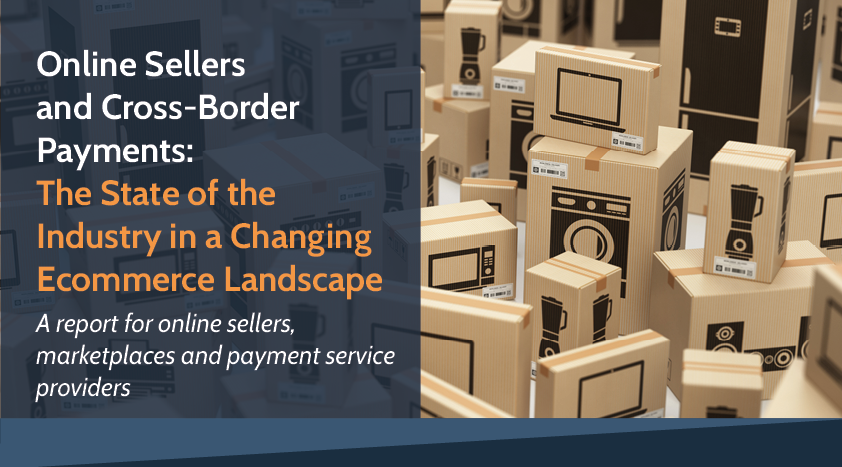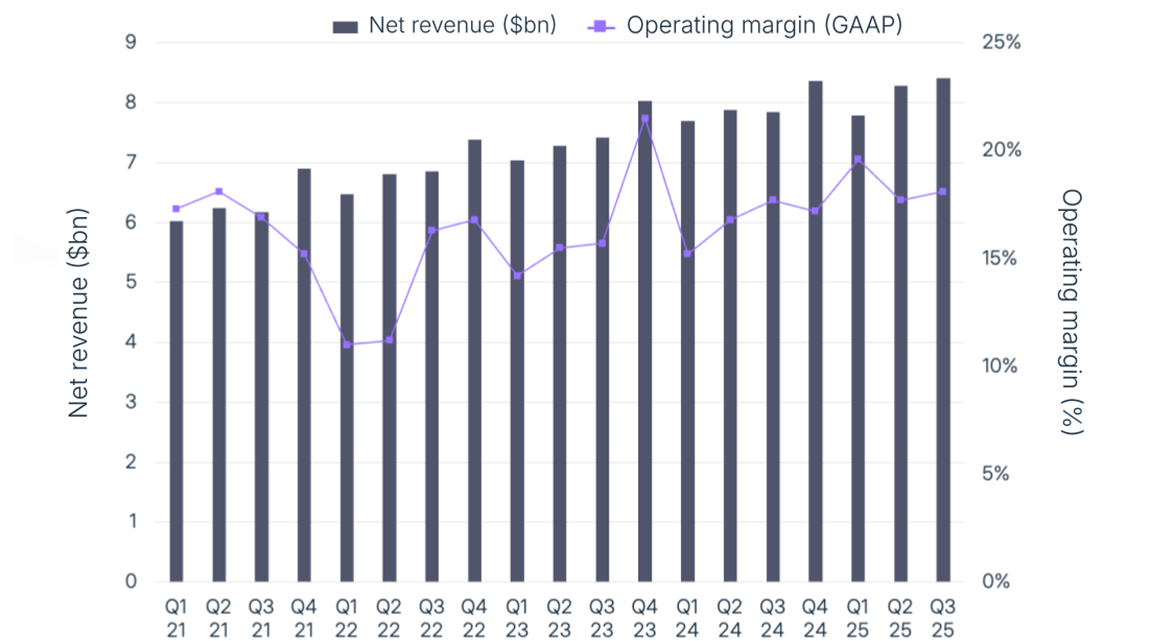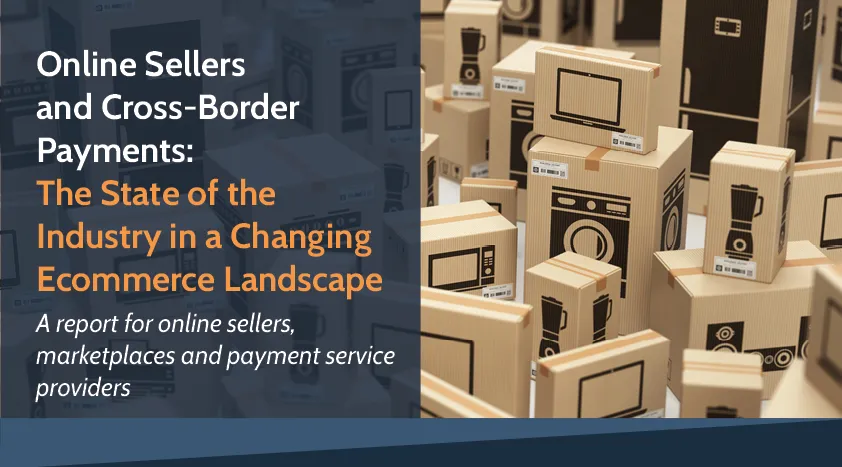
A report for online sellers, marketplaces and payment service providers, featuring exclusive interviews with the CEOs of select Amazon PSPs.
Introduction
Since the start of the pandemic, global ecommerce has witnessed a transformation. While traditional bricks and mortar commerce saw a drop due to lockdowns and social distancing, ecommerce has grown significantly, seeing increased use by existing customers and attracting those who had never previously shopped online.
This is a phenomenon that has occurred globally. Worldwide ecommerce’s share of global retail trade grew from 14% in 2019 to 17% in 2020, according to the United Nations Conference on Trade and Development. It has also been seen in a diverse range of economies, with the biggest shift to digital being seen in emerging economies.
Much of this boost to ecommerce has been received by the world’s major marketplaces, such as AliExpress, Mercado Libre, eBay and global leader Amazon. These provide a platform for online sellers, many of whom sell to consumers globally, taking advantage of the vast international customer bases these marketplaces provide.
While these marketplaces offer significant sales opportunities for such sellers, cross-border ecommerce comes with its own challenges, including both regulatory and FX-related issues. As a result, sellers rely on payment service providers (PSPs) to assist with the process, ensuring that they can get paid for cross-border transactions without falling foul of regional red tape or currency-related hurdles.
However, the pandemic has prompted increased scrutiny of PSPs, with Amazon launching its Payment Service Provider Program that mandates sellers using a PSP to select one from its approved list of participating companies.
Globally spread with a bias towards China, which hosts a high proportion of online sellers, these PSPs serve as the vital connective tissue of cross-border ecommerce, responding to demands from sellers as the market evolves.
In this report we explore the state of ecommerce as seen from the point of view of these PSPs, speaking to the CEOs of many of the biggest such companies to learn what challenges the industry faces, and how it is set to evolve in the future.
Contents
- Introduction
- Online Sellers Market Trends
- Global split and China
- Case study #1: LianLian Global
- Overcoming Challenges in Cross-Border Ecommerce
- Case study #2: Payoneer
- Marketplaces: Amazon and Beyond
- Case study #3: WorldFirst
- Competitive Differentiation
- Case study #4: OFX
- Future Developments
- Conclusion
Online Sellers Market Trends
The current state of the online sellers market is the culmination of what Payoneer CEO Scott Galit describes as the “mass democratisation of participation in global commerce”, as a result of the development of web technologies over the past two decades.
Now, through online marketplaces, a small business owner in one part of the world can cater to customers across multiple continents, with assistance from PSPs. However, as technology advances and consumer demands evolve, so too do the demands on and expectations of online sellers.
Covid-19’s impact on ecommerce
According to several PSPs, Covid-19 has not only accelerated the shift towards online selling, but has also introduced many more companies into the online space, as selling on global marketplaces has become a more viable option compared to traditional bricks and mortar retail.
This has created new business opportunities for PSPs, but it has also created fresh challenges. LianLian Global CEO David Messenger highlighted that this growth has been accompanied by “heightened scrutiny of the quality of online sellers” as well as supporting regulations.
Simply put, with so many new sellers joining online marketplaces, it is important to ensure that quality is maintained and that bad actors aren’t inadvertently given access to customers.
What we’ve seen in the last 18 months is an acceleration of digitalization and the adoption of digital products and services. Huge parts of the world that have been physically locked down. In that time, the world of online shopping exploded. Online businesses, such as Alibaba, Amazon, etc, have hired huge numbers of new staff. Traditional brick and mortar businesses, like Tesco and Sainsbury’s, etc, have also focused a lot on their online capability and capacity. What that resulted in was people that had not previously shopped online and businesses who didn’t have online business models suddenly needed to adapt and become digital natives.
The online seller market has experienced explosive growth across the globe. We’ve seen that growth geographically dispersed, but it has impacted some more than others. Many markets around the world that were hit hard by the Covid-19 pandemic had their supply chains, logistics channels and access to people impacted, while some countries such as China bounced back quicker from an exporter perspective.
Jeff Parker, CEO, WorldFirst
Global split and the dominance of China
While the online sellers market is undoubtedly global, there is a clear skew towards Chinese sellers, who use online marketplaces such as Amazon to access major markets such as the US.
This was already the case prior to the pandemic, although some companies report that this has become more pronounced due to its ability to rapidly capitalize on the sudden rise of ecommerce as Covid-19 began to progress.
This dominance of China is reflected in the disproportionate representation of PSPs participating in Amazon’s Payment Service Provider Program that are either operating in the country or primarily catering to it. LianLian Global also reports that around 70% of the new sellers on Amazon during the pandemic were from China.
However, China is by no means the only region with large numbers of online sellers. OFX CEO Skander Malcolm argues that “this is essentially a global business – whether it’s sellers, marketplaces, PSPs, you have to be global”.
This is reflected both in the regional focuses and regional gains on many of the PSPs not exclusively or primarily focused on China. Payoneer, for example, reported stronger growth in its Q2 2021 earnings in areas including Latin America, Eastern Europe, South Asia, Southeast Asia and the Middle East, with Galit highlighting Eastern Europe in particular as a strong area for ecommerce.
For PSPs, then, while China currently represents a strong total addressable market, the potential of other regions globally should not be overlooked, particularly for those looking to build strong long-term growth.
Amazon’s motivation on the PSP program is around ensuring that sellers on Amazon are high-quality sellers and Amazon can spot the bad actors. Scrutiny, post-Covid concerns about fake PPE, quality of goods or defective goods, all that is putting a lot more pressure on sellers to meet the right quality standards in addition to what they’ve been doing before. So that’s very much front and center, and plays very much into what a PSP needs to be doing if they’re going to be successful supporting online sellers.
David Messenger, CEO, LianLian Global
Figure 1
Online seller locations served by example Amazon PSPs
| PSP | Seller geographic regions |
| LianLian Global | Live: USA, UK, China Pending: Singapore, Indonesia, Vietnam, Ireland, Brazil, Japan, Thailand and Malaysia |
| Payoneer | 190, including China and the USA |
| OFX | USA, Canada, EU, UK, Australia, New Zealand, Hong Kong and Singapore |
| WorldFirst | UK, Europe, UAE, Singapore, Australia, New Zealand, Hong Kong and China |
Changing needs among sellers
Regardless of location, the rise in sellers the pandemic has prompted greater competition, requiring sellers to engage in new approaches to reach and stand out to customers.
Our research identified several common approaches widely reported by PSPs. Firstly, sellers are increasingly looking beyond Amazon to broaden their reach to potential customers. While Amazon is widely regarded as the launchpad to accessing key markets, particularly in the West, sellers are increasingly looking to diversify their reach by expanding to other additional marketplaces.
Furthermore, sellers are also embracing a variety of methods to get their products in front of consumers ahead of their competitors. This includes marketing, including advertising on social media platforms such as Facebook and Instagram, but is also increasingly including engaging in social commerce, which blends traditional social media marketing with D2C commerce.
This can be seen in particular in the rise of video and streaming-based commerce, through platforms such as TikTok as well as through ecommerce streaming channels such as Amazon Live.
These trends create new needs for sellers that PSPs need to meet, including the requirement for easy access to and processing on multiple marketplaces, as well as the ability to easily access and pay for marketing efforts.
For Chinese sellers, the launch pad is Amazon US. Many of them never really went beyond that because they did so well just through that platform, and Amazon provides a great platform for those sorts of sellers. They need a collection service. They needed a US bank account that receives the funds from Amazon, an efficient, reliable service that will actually repatriate the funds to China and take care of the particular compliance and regulations with regard to a Chinese seller moving funds in and out of China.
Over the last five years, those sellers’ needs have evolved and become a lot more complex. They’re trying to run their business, they’ve grown their business, they’ve got to manage suppliers, and they’ve got to pay the Amazon fees. There’s a range of other payments that they have to meet as well as that core function. So all this has pushed us as well as other PSPs to broaden the suite of payment services we offer.
David Messenger, CEO, LianLian Global
The maturation of online marketplaces
As these trends develop, they do so against the backdrop of a changing marketplace environment.
OFX’s Malcolm argues that the last few years in ecommerce have been what he describes as “the gold rush stage”, where the opportunities of ecommerce at scale were being recognised by marketplaces, sellers and payment companies. This, he says, resulted in a rapid proliferation of marketplaces and PSPs catering to particular countries or verticals, with high levels of disruption happening along the way.
However, he now sees the industry as entering a second stage, where we are now beginning to see consolidation of PSPs and the emergence of key global players.
Accompanying this, he says, is a move to “the quality phase” among marketplaces, pointing to Amazon’s Payment Service Provider Program as an example of the increased rigour that is accompanying this.
Amazon are clearly saying that our marketplace, at our size and with our valuation, needs to continue to grow. However, it’s just as important for us to have a very good reputation. And therefore, whether it’s in the seller community or the PSP community, we are now really going to work exceptionally hard at making that marketplace the best marketplace, not just the biggest marketplace.
Skander Malcolm, CEO, OFX
Case Study: LianLian Global
Initially focused on sellers in China, LianLian Global has increasingly been extending its reach globally. While it currently serves online sellers in the US, UK and China, it is adding support for Singapore, Indonesia, Vietnam, Ireland, Brazil, Japan, Thailand and Malaysia in the near future. LianLian Global reports that the total number of ecommerce merchants it serves tops 700,000.
The company offers a selection of value-added products in addition to its cross-border collections service. These include virtual credit cards, integrated cross-border tax services and integrations with shipping and logistics providers. LianLian Global also offers services to help customers accept credit cards and wechat and Alipay payments both online and in-person.
The company’s pricing varies slightly by region, although it focuses on simplicity and transparency in all markets it serves. This includes low fund withdrawal rates, typically 1% or lower, and no annual fees.
The company also offers a variety of promotional offers throughout the year in all the regions it serves. A recent example was offered to sellers impacted by the severe flooding in the Henan region of China, where it waived a number of fees and provided free withdrawals for impacted sellers.
We provide solutions, in real-time, and as soon as funds come from Amazon they’re available in seconds in your bank account. We actually launched a new product which means that once we get the settlement statement from Amazon, we can make the funds available to you before they actually reach our network.
David Messenger, CEO, LianLian Global
Overcoming Challenges in Cross-Border Ecommerce
With such rapid development in cross-border ecommerce and the online seller space, PSPs are not simply required to facilitate the payment of online sellers – they also need to help solve myriad challenges that sellers face in engaging in cross-border retail.
This is seeing PSPs engaging with these challenges, and providing solutions that reduce the burden on individual sellers. However, these are not static issues, but rapidly evolving points of friction that PSPs need to continue to be aware of and respond to with solutions for their customers.
Regulatory and transparency challenges
The regulatory hurdles faced by online sellers differs significantly depending on both where a seller is located, and where they are selling to. While customers expect to be able to order products without friction or unexpected charges, the reality of delivering this will vary over time and by location.
Particular examples of this include the UK, where there are now additional regulatory hurdles for sellers located in the EU, as well as in Europe, where VAT is now being applied to cross-border purchases from outside the bloc.
These changes have had a direct impact on sellers catering to these markets, creating additional costs that either need to be passed onto customers – potentially damaging sales and in some cases reportedly causing sellers to abandon markets altogether – or being absorbed into their bottom line. Furthermore, such regional restrictions in trade create additional paperwork that not only adds complications to the process, but which requires specific regional knowledge, including language skills, to effectively handle.
There are concerns, too, that ongoing regulatory changes in China that are targeting ecommerce and related industries could also cause issues for sellers, with OFX’s Malcolm saying that “we don’t know how that’s going to play out” but adding that he expected there to be “big regulatory responses coming”.
Regulations are one area that PSPs are specifically responding to, by using their size and global expertise to take on regulatory challenges and so ease access to markets for sellers.
EU VAT changes have had an impact for any merchant outside of the EU that wants to export to EU. Non EU merchants used to be exempt from VAT under certain situations and this exemption has now been removed. This means it is now 20% more expensive for these merchants to sell into EU.
Non EU merchants have to either increase their prices or reduce their margins or both. Obviously this will have an impact on the number of merchants wanting to sell into Europe and the total GMV of goods sold by non-EU merchants.
Jeff Parker, CEO, WorldFirst
Logistics challenges
Away from regulatory issues, logistics also pose a challenge for online sellers, with the past year showcasing how troublesome an issue this can be.
At the extreme end, the Suez Canal crisis caused a plethora of issues for global ecommerce, creating disruption and delays that were completely unavoidable for sellers, and yet which customers still expected them to solve. However, the pandemic also created its own disruptions, particularly as lockdowns hit supply chains and impacted delivery channels.
Even during relatively stable periods, moving goods across large areas of the planet is a significant challenge, with sellers facing a host of choices in services to use that vary in costs and reliability.
Many PSPs assist with this challenge by providing embedded logistics support within their wider product suite, which is designed to simplify the process for sellers and again reduce key friction points.
Covid highlighted logistics as a fundamental challenge for merchants. There was a lot of disruption in logistics last year, and you’ve seen a huge growth in VC funding for logistics solutions in the last 12 months to reflect that fact. Fundamentally, if you’re going to do your business cross-border, you’ve got to be able to move the goods, you’ve got to be able to move the funds, and you’ve got to be able to do both in a reliable way.
David Messenger, CEO, LianLian Global
Case Study: Payoneer
US-based Payoneer has one of the biggest global reaches of all Amazon PSPs, serving online sellers based in over 190 countries and territories globally, although its largest markets are China and the US.
The company aims to provide a simple yet comprehensive payments solution for online sellers’ ecommerce business, offering fast payments into a consolidated virtual account, supporting transfers in nine different currencies. Payoneer also enables sellers to pay suppliers and contractors directly from their account, pay for online advertising and other expenses using a virtual card and use B2B AP/AR services to bill international customers and accept payments via credit card or bank transfer. Other services include the ability to pay EU and UK VAT and access working capital.
Payoneer’s pricing is for the most part in the form of a transaction fee that is based on the volume of the transaction, although it also provides same-currency cross-border transactions at a flat rate.
The company offers a variety of seasonal and market-specific promotions. It also has a referral promotion to encourage customers to invite others to use its services, and considers word of mouth to be one of its strongest channels for growth.
Most folks that we talk to and work with are looking to have a diversified business. They’re looking to have tools that help them succeed across that business.
Scott Galit, CEO, Payoneer
Major Marketplaces: Amazon and Beyond
For the vast majority of cross-border sellers, Amazon is the first port of call in global ecommerce, providing something of a gold standard for the wider industry. This makes recent advances around its PSP program particularly significant.
However, while it remains vital to the industry, it is not the only marketplace – and others are growing.
Amazon’s PSP program
Launched in March 2021, Amazon’s PSP program mandates the use of approved PSPs by sellers. This means organisations wishing to provide their services to those selling on the platform need to comply with a range of requirements, largely focused around combating fraud and abuse. These include having adequate risk and compliance controls in place, as well as exchanging information with Amazon as required.
The rollout was major news for both sellers and PSPs, attracting considerable coverage in the B2B ecommerce press. However, Amazon at the time highlighted that it expected over 90% of those using PSPs to already be doing so with an organisation enrolled in the new program.
Our own research on enrolled PSPs has found a positive mindset about the program, with WorldFirst’s Parker describing his perception of it as “extremely positive”, highlighting that it provides data points that can be used to improve the company’s offerings to sellers, as well as providing greater transaction visibility to sellers and the ability to automate certain processes to reduce friction.
The PSP industry appears to recognise that strong operational structures are necessary to an industry that is facing greater scrutiny and increased regulation – and is seeing the benefits that accompany it.
Amazon is often the first entry point into selling overseas for merchants because they make it so easy for those sellers to test their international strategy. Once they have successfully tested they can then decide if there are other channels they want to sell through as well.
My general view on the program is extremely positive. Being integrated with Amazon allows us to better support our merchants. We can automate processes reducing friction and provide better, more tailored services which can only be good for our merchants.
Jeff Parker, CEO, WorldFirst
Figure 2
Companies participating in Amazon’s PSP program
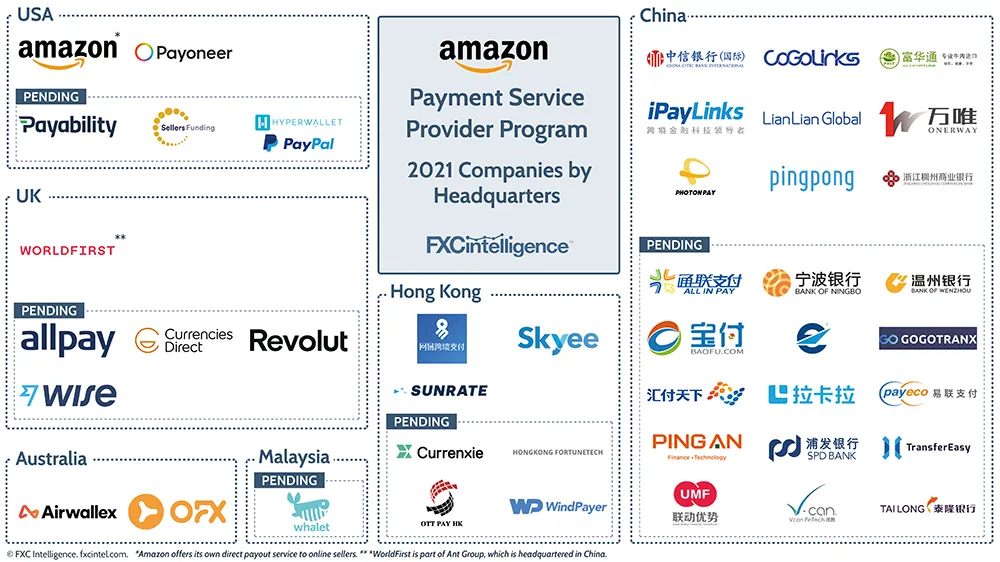
Competing with Amazon
A particular quirk of Amazon’s PSP program, however, is that participating companies not only are competing with each other, but also with the ecommerce giant itself. Sellers do not need to use a third-party PSP program, but can instead opt just to deal with Amazon directly. However, none of the PSPs we spoke to for this report expressed concern about this.
OFX’s Malcolm characterises the practice as typical to the company’s approach, saying that Amazon’s philosophy is that “ultimately the best product wins”.
“Their indigenous payment companies will win sellers because they’re Amazon and there’ll be certain sellers that will never go with Amazon Pay, but would go with OFX,” he says. “Amazon Pay is very expensive. It’s public: they charge one and a half percent.”
Payoneer’s Galit echoes this, saying that Amazon is “not the strongest competitor”.
This sentiment is also echoed by LianLian Global and WorldFirst, with Parker highlighting that Amazon’s product remains limited compared to PSPs as it is restricted to a single currency and market, and has only automated payout.
If you’re a merchant, you use what you want to use. In certain areas, Amazon is going to have incredible advantages. Outside of that in practice what we see is actually most of the folks that are working with Amazon are not looking to get closer to Amazon.
Scott Galit, CEO, Payoneer
Amazon faces some challenges from a financial regulatory point of view in terms of antitrust concerns if they expand into payments. They do have an offering, but it’s not at the scale that we are. And it isn’t comprehensive in terms of the range of services we provide. It’s not just the core collection services, it’s all of the other services. And also on price, Amazon is not competitive in most cases. So we don’t see their solution being a major factor for cross-border sellers.
David Messenger, CEO, LianLian Global
Marketplaces beyond Amazon
All of the PSPs we spoke to in researching this report provide services for sellers on multiple marketplaces, and although Amazon remains a vital part of the online seller ecosystem, it is by no means the sole option. Several PSPs reported that merchants are increasingly seeking out new channels, and value the ability to expand to these with the support of their provider.
Other marketplaces frequently mentioned include eBay and Alibaba, with OFX’s Malcolm also highlighting Walmart as a marketplace that looks set to grow significantly in the future.
For sellers looking to grow their businesses, selling across numerous marketplaces is seen as a vital component – and PSPs specifically structure their offerings with this in mind.
Most of the folks that we talk to in the market recognize Amazon is incredibly important, but well over two thirds of our volume is with customers that use us to get paid from more than one source. And they’re looking for tools beyond simply settlement into a local bank because they’re trying to build and manage and grow a global business.
Scott Galit, CEO, Payoneer
Figure 3
FXC Intelligence’s cross-border ecommerce 100
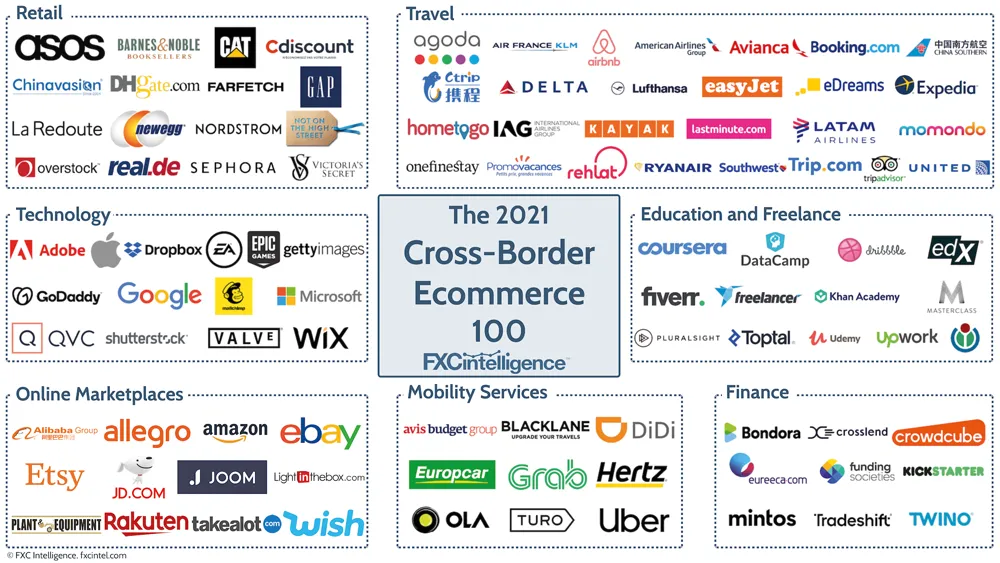
Case Study: WorldFirst
Serving online sellers in the UK, Europe, UAE, Singapore, Australia, New Zealand, Hong Kong and China, Ant Group-owned WorldFirst provides support for local collection in 10 different markets.
The company provides a variety of additional services for online sellers, including the ability to open up to 10 local currency accounts, in which sellers can hold funds and pay suppliers. Other services include the ability to make quick international money transfers, manage risk with hedging solutions and send mass payments with a single transaction.
WorldFirst’s pricing is made up of a payment fee and a fixed currency conversion fee, with different rates depending on the amounts involved. For collections accounts, amounts up to £500,000 are charged at 0.6%, while amounts between £500,000 and £5m are charged at 0.35%. The company also offers same-currency transfers, which vary in price depending on the currency and country of payment.
At present, WorldFirst offers incentives through its channel partnership with Alibaba, where customers can get discounts on Alibaba seller membership packages by using WorldFirst.
When we talk about online sellers, it’s very much about this ability to provide local collections accounts.
The number of currencies that we provide – we’ve got 10 locally domiciled currencies around the world, so if you’re an exporter that’s looking to sell in multiple markets, we feel we’re very competitive from that perspective. With price, we believe we are market leading. Importantly, around price, we very much focus on transparency, which is relatively unique within the FX and payment space. Customers always understand upfront what their costs are, and it’s based on the volume of trades they do. We’ve seen that resonate very strongly with customers.
Jeff Parker, CEO, WorldFirst
Competitive Differentiation
Providing effective support for online sellers on the world’s leading marketplaces is a vital role of PSPs, but standing out in what can be a crowded marketplace can be challenging.
For both sellers and PSPs, ecommerce presents an increasingly competitive market, with the latter providing growing ranges of products to most effectively cater to their customers.
Pricing and products
Pricing is, naturally, a key differentiator among PSPs, and is notably influenced by the pricing pressures of the online sellers space itself, particularly given the dominance of Chinese sellers.
OFX’s Malcolm explains that this has traditionally led to intense competition on price:
“Chinese sellers were very, very price-driven. And the indigenous Chinese providers were offering very, very sharp, like one or two basis points margins,” he says.
“In the case of the major players, they’re cross-subsidizing it with lending products. So they say, we’ll give you the FX for three or four basis points, so long as you take the lend. And that’s where they make their money.”
WorldFirst’s Parker agrees that there was previously an aggressive approach to pricing.
“If we were to have had this conversation a couple of years ago, I’d say the general trend was a downward trend in terms of pricing. There was lots of talk about the race to the bottom and free FX, etc.,” he explains.
“I think that’s stabilized now. Now what we’re starting to see, and will continue to see more of, is as new products and services start to be offered with different prices.”
This, he says, is producing a more complex approach to pricing.
“Whether it’s a card attached to the account, acquiring or invoicing etc., you’ll start to see relationship pricing and an increase in the revenue per customer,” he says.
“Some of the newer value-added products will likely be at higher margins than the simple cross-border payments, and payments and FX will be used as the acquisition hook. We’ll no doubt continue to see more regionalised pricing as the needs and wants of customers in different locations are better understood and serviced accordingly.”
Notably, however, PSPs are seeing regional variation in pricing, in response to local expectations and pricing pressures. Payoneer’s Galit argues that “within bands of customer segments, actually there’s pricing stability”.
“It will tend to be more size and vertical market. And probably the number one would be size,” he says.
“There can be variance based on geography and obviously different geographies have different levels of competitors that are there, which certainly will have some impact,” he says. “But the vast majority of what goes on is not competition”.
While pricing is a key factor for some online sellers, PSPs are also seeing increased prioritisation on reliability and trust over low cost, something that LianLian Global’s Messenger identifies.
“When it comes to our own pricing, it’s a very competitive market, but price isn’t the only factor,” he says.
“One of the things we see is that what merchants first and foremost care about is how reliable is my PSP. Is my PSP going to run into a regulatory issue where the account gets frozen, and funds are delayed? If you don’t have that trust as a PSP, then price is a secondary concern.”
Figure 4
How example PSPs structure pricing
| Annual fees? | Charge to withdraw funds? | Custom pricing for volume customers? | Incentives / promotions? | |
|---|---|---|---|---|
| No | Yes | Yes | Promotional offers throughout the year | |
 | No | Yes | Yes | Referral promotions, market, season-specific promotions |
 | No | No | Yes | |
| No | Yes | Yes | Promotions for Alibaba sellers |
Value-added services
Significantly, the range of products offered by PSPs are not simply limited to helping sellers get paid, but have expanded to meet the varying financial and operational needs they face.
Some include services to make it easier for sellers to set up on new additional marketplaces, with LianLian Global, for example, offering a one-click solution for this purpose.
Many also provide solutions for marketing-related activities, including virtual multicurrency cards that enable sellers to easily pay for adverts and other related services on social media platforms and beyond in the countries of their target customers.
Lending, meanwhile, represents a significant opportunity for PSPs, with online sellers often requiring cashflow in order acquire stock to sell. Here, having data on a seller’s operational history and practices can provide vital information in determining creditworthiness that would be inaccessible to standalone fintechs and other financial institutions.
Then there is the longstanding importance of customer service. While many PSPs operate at scale, customer service remains essential to an industry whose customer base is at least in part dominated by small businesses.
Moving money is critical and can be emotive. We pride ourselves that we have the best service in the market. Regardless of how much we continue to evolve our technology our customers will always be able to pick up a phone and talk to an account manager. I wholeheartedly believe that a small business will always have the need to talk to a real person. We feel that’s an important part of our value proposition.
Jeff Parker, CEO, WorldFirst
Figure 5
Additional services offered by example PSPs
 |  | |||
|---|---|---|---|---|
| Virtual Cards | Yes | Yes | Not yet but planned | Coming in Q4 2021 in China, followed by global expansion |
| Multicurrency Account | No | Yes | Yes | Customers can open up to 10 local currency accounts |
| Cross-Border Tax Services | Yes | Yes | Via partnerships | Yes |
| Shipping and Logistics Integrations | Yes | Yes | Not integrated but via partnership | Currently in China, global rollout planned |
| Global Money Transfers | Yes | Yes | Yes | Yes |
| Working Capital | Yes but only in some regions | Yes | Via partnerships | Currently in China, global rollout planned |
| Same-Currency Cross-Border Transactions | Undisclosed | Yes – flat rate fee | Yes – fee based | Yes |
| Support for Sellers to Hold Funds | Undisclosed | Yes – no cost, with support to receive in USD, EUR, GBP, CNH, JPY, AUD, CAD, SGD and MXN | Yes – no cost in USD, CAD, EUR, GBP, AUD, HKD, SGD. Payout in 50+ currencies | Yes – no cost, with support to receive in GBP, EUR, USD, AUD, SGD, CAD, JPY, NZD, HKD and CNH |
Case Study: OFX
Australia-based OFX is licensed and regulated in 8 global jurisdictions, and serves customers who are either registered or selling on a marketplace in Singapore, Australia, New Zealand, Canada, Hong Kong, the US, EU and UK.
In addition to enabling customers to get paid by online marketplaces, payment gateways and direct from customers, OFX also offers a global currency account to manage multiple currencies, global money transfers, supplier payments and the ability to connect to business services, including the Xero account platform. It also enables sellers ot hold funds in a wallet at no cost, with support for USD, CAD, EUR, GBP, AUD, HKD and SGD at present and more planned in the future. The company supports payouts in over 50 global currencies.
OFX does not charge receiving fees, and only charges a margin when sending funds, such as to local bank accounts, or to pay taxes or suppliers. The company also enables sellers to send money between OFX accounts for free or send same-currency transfers domestically or internationally for a fee.
The first piece is that we’re global. The second thing is that we have, in our opinion, a very unusual we call it digital plus human combination. And the reasoning you need both is the sellers want self-service, and it’s all got to work, that’s digital.
But there are also people who are not foreign exchange experts, and they are increasingly, in our experience anyway, they are what my CFO calls working capital kings. They are literally turning over inventory as fast as they possibly can. So they’re very exposed if they get that piece wrong. Some of that can be solved digitally. Some of it has to be solved by talking to people. And we think it’s the combination that’s special.
Skander Malcolm, CEO, OFX
Future developments in cross-border ecommerce
While the ecommerce industry has witnessed significant developments over the past few years, it has by no means reached a plateau. Future developments are likely to continue to enact significant changes, and in doing so will create fresh demands on PSPs and their customers.
The shift to digital
It is now widely accepted that the vast majority of the customers that shifted online during the pandemic are being converted into long-term online consumers, meaning that while the ecommerce landscape may not continue the explosive growth it saw during the height of Covid-19, it is set to continue to increase in scale and reach.
While this is positive news for PSPs and sellers who have benefited from this, it also indicates that we are likely to continue to see developments not only in the technological capabilities of marketplaces and their surrounding ecosystems, but also in the habits of the consumers that use them and the regulations and scrutiny that they are governed by.
For those operating in this space, it is therefore vital to remain reactive to change and continue to develop offerings to respond to the changing needs of the industry.
My personal view is that the growth we have seen in the online seller market is a permanent shift towards digitalization. The pace of growth has slowed as the physical economy is re-opening but I don’t think that it will contract in size.
Jeff Parker, CEO, WorldFirst
Global expansion
The online sellers industry has become increasingly competitive over the last few years, and those operating in the space have increasingly looked beyond the core marketplaces for future growth. For PSPs, however, there has also been a renewed global focus.
While PSPs such as Payoneer and OFX that are not exclusively focused on China are cultivating greater customer bases beyond the country, traditionally Chinese companies are also looking to expand globally. LianLian Global, for example, is currently expanding to support sellers across parts of Europe, the US and Asia-Pacific as part of a plan to broaden its geographic footprint.
This reflects the wider sentiment that while China remains a heavy hitter in the online sellers space, there are increasing opportunities beyond the country, and we are likely to see this trend develop over the next few years, particularly if growing regulation makes cross-border commerce increasingly viable in some corridors compared to others.
I don’t think it’s going to be winner take all. I think there’ll be very big-scale players and there’ll be specialists who are trying to differentiate for the marketplaces and the sellers around value-add. And some folks will value that and some won’t.
Skander Malcolm, CEO, OFX
Beyond core marketplaces
The growing demand for channels beyond core marketplaces is increasingly also creating new opportunities for PSPs to broaden their offerings.
Social commerce is one area with growing potential that PSPs are identifying, with several providing direct solutions specifically catering to social media-based ecommerce. Several PSPs we spoke to identified this as an area of future growth, including through streaming and video-based commerce, which is emerging on platforms such as TikTok.
However, some PSPs are also branching into the ecommerce opportunities of B2B trading, with traditional import, export increasingly moving online. LianLian Global, for example, identified this as a key area, highlighting that traditional processes such as factory visits had been upended by the pandemic, creating a need for more digital solutions. And while this may seem like an entirely separate industry, many of the larger sellers are likely to engage in a mixture of B2B and D2C, making this a key area for PSPs to engage with.
One of the big new areas is actually not the traditional B2C commerce, it’s actually what has been offline B2B general trading – import and export. And Covid has changed the game there, so we’ve got a situation where on the business side, they’re looking for a new solution because you can’t come to the expo in China and meet a bunch of suppliers, then do the factory visits.
David Messenger, CEO, LianLian Global
Blockchain and cryptocurrency
There is also potential for disruption from both blockchain and cryptocurrency, although for quite different reasons.
Blockchain is a technology already being explored for use in supply chains, and so has potential to assist with the transparency and traceability of cross-border trade. WorldFirst’s Parker identifies this as having particular potential as the industry sees an increasing blending between offline and online commerce.
Cryptocurrency, meanwhile, is increasingly being explored as a payment method in ecommerce, with PayPal now allowing users to make purchases using a selection of digital currencies, and brands such as Visa and Mastercard also exploring the area. However, while none of the PSPs we spoke to are focused on adding cryptocurrency capabilities to their own product suite at present, OFX’s Malcolm did identify Facebook Marketplace as a potential disruptor in this area.
We believe there’s a huge opportunity out there, it’s much bigger than just the online seller space. We see SMEs increasingly expanding the channels they buy and sell on, the geographies they buy from and sell to and they are happy to look at offline and online relationships. I think the blockchain plays a really important part in the future especially in the B2B and offline space to make it really secure and safe at scale. So, we’re doing a lot of thinking around how do we leverage this technology effectively.
Jeff Parker, CEO, WorldFirst
The Facebook move will be very, very interesting, because the rumor is that they’re going to mandate Diem at some point. And if that happens, then sellers will be put in a tough place. If I want to be on Facebook Marketplace, which looks very attractive, I have to use Diem. And then we get into that crypto conversation – it’s essentially going to be an off-board out of Diem into US dollars or whatever it is. That will be a real challenge. That’s what Amazon has said we’re not going to.
Skander Malcolm, CEO, OFX
Conclusion: Online sellers and cross-border payments
The online sellers industry is currently in a both a strong growth and transitional state that, due to the pandemic, has arguably arrived several years earlier than may have previously been expected. It is now a vital industry for millions of consumers around the world, with PSPs ensuring that essential cross-border transactions can take place smoothly, efficiently and with trust.
For millions of sellers, PSPs are therefore a vital part of the selling process, not only ensuring that they get paid without hassle, but helping them access new channels; attract customers and comply with all regulatory requirements.
This makes PSPs essential to the ecommerce industry, and creates tremendous opportunities for their development and growth, but it also creates challenges for them to overcome. It is not simply a matter of FX – PSPs must compete on price, service and capabilities in a market that is changing rapidly both in terms of size and user habits, but also in terms of regulations.
So much has changed over the course of the pandemic, but there is significantly more change to come. PSPs will need to be responsive and proactive to best grow their businesses, and support the growth of their customers’ business too.
